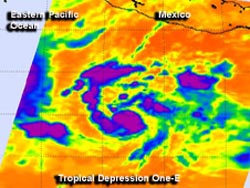NASA Sees First Eastern Pacific Tropical Depression to Open Season

NASA’s Aqua satellite flew over Tropical Depression 1-E (TD1E) at 0823 UTC (4:23 a.m. EDT) and the Atmospheric Infrared Sounder (AIRS) instrument captured an infrared image of the storm. AIRS data showed bands of thunderstorms wrapping into the low-level center from the west, as well as a fragmented band of thunderstorms east of center. Credit: NASA JPL/Ed Olsen<br>
The first tropical depression formed around 11 a.m. EDT on May 15. NASA’s Aqua satellite flew over Tropical Depression 1-E (TD1E) at 0823 UTC (4:23 a.m. EDT) and the Atmospheric Infrared Sounder (AIRS) instrument captured an infrared image of the storm.
AIRS data showed bands of thunderstorms wrapping into the low-level center from the west, as well as a fragmented band of thunderstorms east of center. Cloud top temperatures of the thunderstorms were as cold as -63 Fahrenheit (-52 Celsius) indicating strong thunderstorms with heavy rainfall potential.
At 11 a.m. EDT on May 15, TD1E had maximum sustained winds near 35 mph (55 kph). It was located far from land, about 650 miles (1,045 km) south-southwest of Acapulco, Mexico, near 9.2 north latitude and 103.6 west longitude. TD1E was moving to the west at 12 mph (19 kph) and had a minimum central pressure near 1006 millibars. There are no coastal warnings or watches in effect.
The National Hurricane Center noted that TD1E will be moving through warm waters over the next couple of days, which will likely strengthen it into Tropical Storm Alvin.
Text credit: Rob Gutro
NASA’s Goddard Space Flight Center
Media Contact
All latest news from the category: Earth Sciences
Earth Sciences (also referred to as Geosciences), which deals with basic issues surrounding our planet, plays a vital role in the area of energy and raw materials supply.
Earth Sciences comprises subjects such as geology, geography, geological informatics, paleontology, mineralogy, petrography, crystallography, geophysics, geodesy, glaciology, cartography, photogrammetry, meteorology and seismology, early-warning systems, earthquake research and polar research.
Newest articles

Making diamonds at ambient pressure
Scientists develop novel liquid metal alloy system to synthesize diamond under moderate conditions. Did you know that 99% of synthetic diamonds are currently produced using high-pressure and high-temperature (HPHT) methods?[2]…

Eruption of mega-magnetic star lights up nearby galaxy
Thanks to ESA satellites, an international team including UNIGE researchers has detected a giant eruption coming from a magnetar, an extremely magnetic neutron star. While ESA’s satellite INTEGRAL was observing…

Solving the riddle of the sphingolipids in coronary artery disease
Weill Cornell Medicine investigators have uncovered a way to unleash in blood vessels the protective effects of a type of fat-related molecule known as a sphingolipid, suggesting a promising new…





















